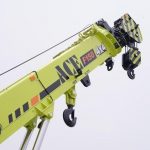
Wood on wood drawer guides are traditional mechanisms using wooden slips with grooves, attached to drawer sides, ensuring smooth operation and durability in furniture design.
1.1 Definition and Purpose
Wood on wood drawer guides are traditional mechanisms that rely on wooden components to facilitate smooth drawer movement. These systems typically consist of narrow wooden slips with grooves, attached to the drawer’s sides, which guide the drawer bottom. Their primary purpose is to ensure stability, alignment, and effortless operation of drawers in furniture. Unlike modern drawer slides, wood on wood guides depend solely on the natural friction and fit of the wood, making them a simplistic yet durable solution. They are often preferred in high-quality, handcrafted furniture for their timeless aesthetic and ability to withstand heavy use over time. This design emphasizes craftsmanship and functionality, making it a cornerstone in traditional furniture design.
1.2 Historical Background
Wood on wood drawer guides have their roots in traditional furniture-making techniques that date back centuries. Early cabinetmakers developed these systems to create smooth-operating drawers without the need for metal hardware. The use of wooden slips with grooves became a hallmark of high-quality, handcrafted furniture during the 18th and 19th centuries. Skilled craftsmen relied on precise woodworking skills, such as hand-planing and chiseling, to create these guides. Over time, the design evolved to incorporate slight improvements, but the core principle remained unchanged. By the mid-20th century, metal drawer slides became more prevalent, yet wood on wood guides persisted in artisanal and custom furniture-making, cherished for their timeless appeal and durability. This traditional method continues to be celebrated today for its simplicity and craftsmanship.
1.3 Importance in Furniture Design
Wood on wood drawer guides hold significant importance in furniture design due to their timeless aesthetic appeal and functional durability. Unlike metal slides, they blend seamlessly into the design, maintaining a clean and minimalist appearance. Craftsmen value these guides for their ability to showcase precise woodworking skills, as they rely on exact tolerances and traditional techniques. The system’s simplicity enhances the overall user experience, offering smooth and quiet operation. Additionally, wood on wood guides are highly durable and require minimal maintenance, making them a practical choice for both modern and traditional furniture designs. Their sustainability and renewable nature further contribute to their popularity in eco-conscious furniture-making. This traditional mechanism remains a cornerstone of high-quality, handcrafted furniture, emphasizing both form and function.
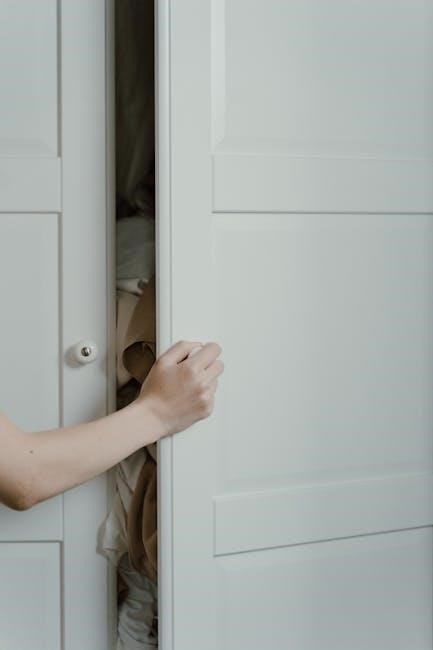
How Wood on Wood Drawer Guides Work
Wood on wood drawer guides operate using wooden slips with grooves, attached to drawer sides, enabling smooth sliding through wood-on-wood contact, ensuring durability and alignment without metal hardware.
2.1 Mechanism of Operation
Wood on wood drawer guides function through a simple, durable mechanism where wooden slips with grooves are attached to the drawer sides. These grooves align with corresponding parts on the drawer bottom, allowing smooth sliding. The wooden components work together to ensure proper alignment and even weight distribution. This traditional system relies on the natural friction and fit of wood, eliminating the need for metal hardware. The mechanism promotes quiet operation and withstands heavy use over time. By leveraging the inherent strength and stability of wood, these guides provide a reliable and long-lasting solution for drawer systems in various furniture designs.
2.2 Key Components
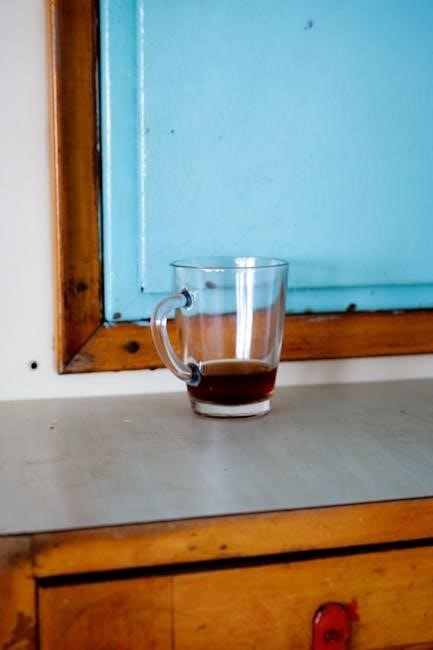
The primary components of wood on wood drawer guides include the drawer slips, drawer sides, and the grooved bottom. Drawer slips are narrow, grooved pieces of wood attached to the drawer sides, providing a smooth surface for the drawer to slide. The drawer sides are the vertical panels of the drawer, which house the slips and support the drawer’s structure. The grooved bottom fits into the slips, ensuring proper alignment and stability. Together, these components create a durable and friction-resistant system, enabling smooth drawer operation without the need for metal hardware. The simplicity of these components contributes to their reliability and longevity in various furniture applications.
2.3 Advantages Over Other Systems
Wood on wood drawer guides offer several advantages over metal-based systems. They provide a quieter and smoother operation due to natural wood-on-wood friction, which reduces noise and wear. Unlike metal slides, wood guides are less prone to bending or breaking under weight, making them highly durable. Additionally, they blend seamlessly with traditional furniture designs, maintaining a timeless aesthetic without visible hardware. The absence of metal components also eliminates the risk of rust or corrosion. Furthermore, wood guides are often easier to repair and require minimal maintenance, making them a practical choice for high-quality, long-lasting furniture; Their simplicity and effectiveness have made them a preferred option for craftsmen and furniture enthusiasts seeking a reliable and visually appealing solution.
Materials and Manufacturing
Wood on wood drawer guides are crafted from high-quality, durable woods like oak or maple, ensuring strength and smooth operation. The manufacturing process involves precise cutting and grooving to fit drawer bottoms seamlessly, providing a traditional, reliable solution for furniture drawer systems.

3.1 Types of Wood Used
Wood on wood drawer guides typically utilize durable, high-quality wood species such as oak, maple, or cherry. These woods are chosen for their strength, stability, and ability to support weight without warping. Oak is often preferred for its traditional appeal and robust grain structure, while maple offers a smoother, more modern look. Cherry is valued for its rich color and fine texture. The density and tight grain of these woods ensure minimal wear and tear, making them ideal for drawer guides that require consistent performance. Properly seasoned and finished, these materials enhance both functionality and aesthetic appeal in furniture design.
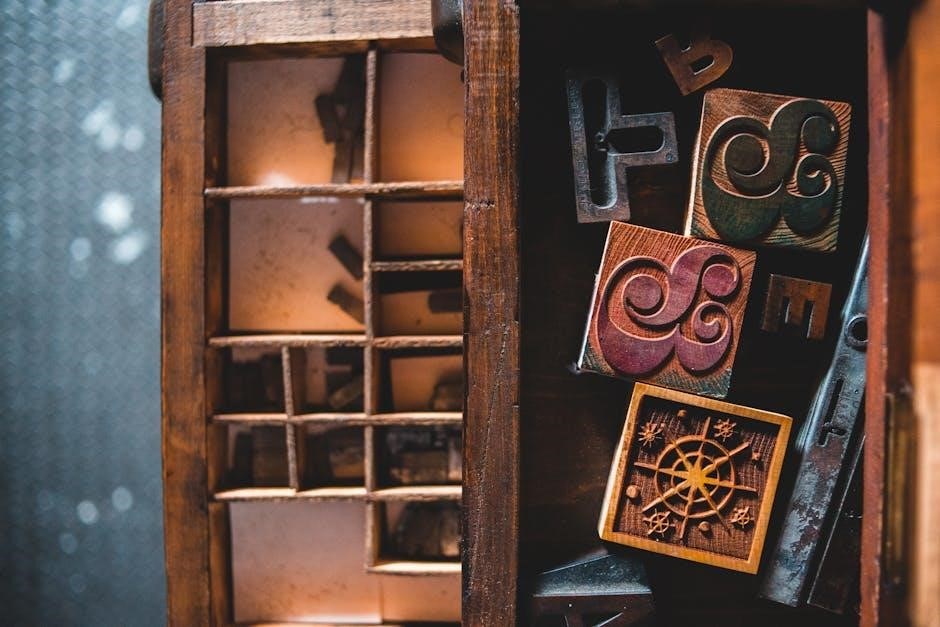
3.2 Manufacturing Process
The manufacturing of wood on wood drawer guides involves precise cutting and shaping of wood to create the necessary components. The process begins with selecting and seasoning the wood to ensure stability. Next, the wood is cut to the required dimensions, and grooves are carefully milled to accommodate the drawer bottom. These grooved slips are then sanded smooth to ensure a friction-free glide. Finally, the slips are attached to the drawer sides using strong adhesives and secured with clamps until the glue sets. The entire process emphasizes craftsmanship and attention to detail to ensure durability and smooth operation. Quality control measures are implemented to guarantee each guide meets performance standards.
3.3 Quality and Durability Factors
The quality and durability of wood on wood drawer guides depend on the type of wood used, proper seasoning, and precise fitting. Hardwoods like oak and maple are preferred for their strength and resistance to wear. Proper seasoning ensures the wood remains stable and resistant to warping. A snug fit between the drawer and the guides is crucial for smooth operation and to prevent excessive wear. Regular maintenance, such as keeping the wood conditioned and clean, further enhances longevity. High-quality adhesives and craftsmanship also play a significant role in ensuring the guides withstand daily use over time. These factors combined contribute to the overall performance and lifespan of the drawer guides.
Installation and Adjustment
Proper alignment and fitting of the drawer sides to the guides ensure smooth operation. Adjustments may be needed to achieve optimal performance and even movement.
4.1 DIY Installation Tips
Installing wood on wood drawer guides requires precision and patience. Start by ensuring the drawer and cabinet are properly aligned. Measure the drawer sides accurately to determine where the guides will be attached. Use clamps to hold the guides in place before gluing or screwing them into position. Sand the surfaces to ensure a smooth fit and apply a small amount of wood glue for added stability. Allow the adhesive to dry completely before testing the drawer’s movement. If the drawer feels uneven, make minor adjustments to the guide positions. Regularly check and tighten screws to maintain optimal performance over time.
4.2 Professional Installation
Professional installation of wood on wood drawer guides ensures a flawless and durable setup. Skilled craftsmen use specialized tools to align and fit the guides perfectly, minimizing wear and tear. They employ precise measuring techniques and often pre-drill holes to avoid splitting the wood. High-quality adhesives and screws are used to secure the guides, guaranteeing stability. After installation, professionals test the drawers for smooth operation, making adjustments as needed. Their expertise ensures the furniture maintains its aesthetic appeal and functionality. Hiring a professional is recommended for intricate or antique pieces, where precision is crucial for preserving value and performance.
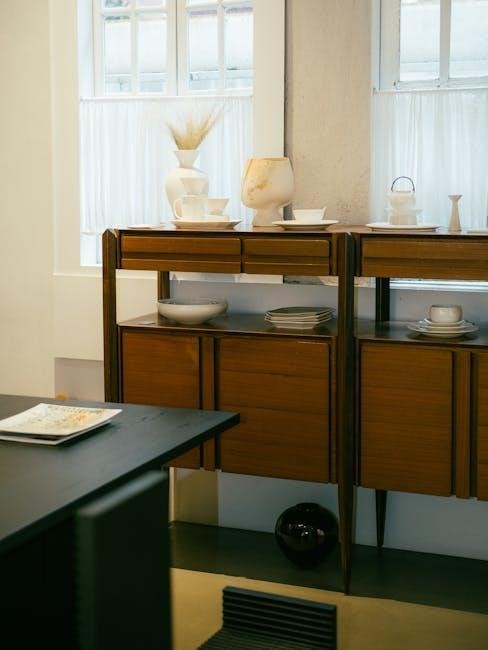
4.3 Adjusting for Smooth Operation
Ensuring smooth operation of wood on wood drawer guides requires precise adjustments. Start by checking the alignment of the drawer and the guides, making sure they are properly fitted. Gently sand any uneven surfaces to eliminate friction. Apply a small amount of wax or natural oil to the contact points to reduce sticking. Tighten all screws securely, but avoid over-tightening, which can impede movement. For drawers that sag, adjust the rear guides to lift the drawer slightly. Regularly inspect and clean the grooves to remove dust or debris. These simple steps ensure optimal performance and extend the lifespan of the drawer system.

Maintenance and Care
Regular cleaning with a soft cloth and lubrication with natural oils or wax ensures smooth operation. Avoid harsh chemicals and heavy loads to prevent wear and tear.
5.1 Cleaning and Lubrication
Cleaning and lubricating wood on wood drawer guides is essential for maintaining smooth operation. Use a soft, dry cloth to remove dust and debris from the surfaces. Avoid harsh chemicals, as they can damage the wood finish. For lubrication, apply a small amount of natural wax, such as beeswax or paraffin oil, to the grooves and contact points. This reduces friction and prevents sticking. Regular cleaning every 3-6 months ensures optimal performance. Inspect the guides for worn or uneven surfaces and address them promptly to maintain functionality. Proper care extends the lifespan and ensures drawers open and close effortlessly.
5.2 Troubleshooting Common Issues
Common issues with wood on wood drawer guides include sticking, uneven movement, or excessive noise. Start by inspecting for dust or debris, which can be removed with a soft brush or cloth. If drawers stick, lightly sand the contact surfaces to smooth them out. For misalignment, adjust the drawer slips or guides to ensure proper fit. Lubricate with wax or oil if friction is high. If damage is present, replace worn-out slips or guides. Avoid using harsh chemicals, as they can harm the wood finish. Regular maintenance and inspections can prevent these issues from arising. Addressing problems early ensures the longevity and smooth operation of the drawer system.
5.3 Extending Lifespan
To extend the lifespan of wood on wood drawer guides, regular maintenance is essential. Clean the guides periodically with a soft cloth to remove dust and debris, which can cause friction. Apply a small amount of natural wax or oil to the contact surfaces to reduce wear and tear. Ensure proper alignment during installation and use to prevent uneven stress. Avoid exposing the wood to excessive moisture, as it can warp or degrade the material. Refrain from using harsh chemicals, as they can damage the finish or wood grain. By following these care tips, you can maintain the functionality and appearance of your wood drawer guides for years to come.
Wood on Wood vs. Modern Drawer Slides
Wood on wood drawer guides offer a traditional, organic feel, while modern slides provide smoother operation and greater durability, making them a popular choice for contemporary furniture designs.
6.1 Comparison of Performance
Wood on wood drawer guides provide a smooth, quiet operation and a traditional aesthetic, while modern drawer slides often offer improved durability and weight capacity. Modern slides, particularly metal-based systems, are designed for heavier loads and longer lifespan, reducing wear and tear over time. Wood on wood guides rely on precise craftsmanship to ensure smooth gliding, but they can be more prone to sticking if not properly maintained. In contrast, modern slides often feature advanced lubrication and ball-bearing mechanisms, enhancing performance and requiring less upkeep. The choice between the two ultimately depends on the desired balance between tradition, weight tolerance, and maintenance preferences.
6.2 Aesthetic and Design Differences
Wood on wood drawer guides offer a timeless, natural aesthetic that blends seamlessly with traditional furniture designs. The visible wooden components create a classic, handcrafted appearance, appealing to those who value authenticity and rustic charm. In contrast, modern drawer slides are often concealed, providing a sleek, minimalist look. Metal or synthetic slides can be powder-coated in various colors, offering design flexibility. Wood on wood guides emphasize simplicity and heritage, while modern systems prioritize contemporary style and versatility. The choice between the two reflects the desired visual and tactile experience, with wood on wood evoking warmth and tradition, and modern slides delivering a polished, industrial edge.
6.3 Cost and Value Analysis
Wood on wood drawer guides are often more cost-effective than modern drawer slides, as they utilize natural materials and simpler manufacturing processes. Their traditional appeal can justify higher prices in niche markets, especially for custom or antique furniture. Modern slides, while more expensive upfront, offer durability and low maintenance, making them a practical long-term investment. Wood on wood guides may require occasional lubrication or adjustment, potentially increasing lifetime costs. However, their aesthetic value and historical charm often outweigh these factors for enthusiasts of traditional furniture design. Ultimately, the choice depends on balancing budget, desired functionality, and design preferences.
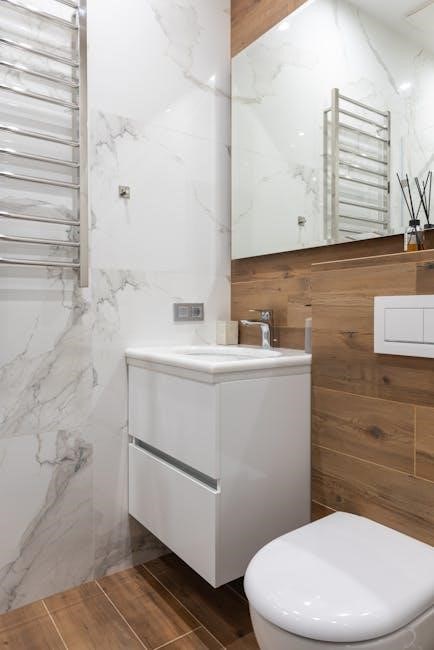
Common Problems and Solutions
Common issues include sticky drawers and misalignment. Solutions involve sanding surfaces, applying wax, or adjusting guides. Regular maintenance ensures smooth operation and longevity of the drawer system.
7.1 Addressing Sticky Drawers
Sticky drawers are a common issue with wood on wood drawer guides, often caused by moisture, wear, or improper alignment. To fix this, start by sanding the drawer sides and slides to smooth out any rough spots. Apply a small amount of wax or silicone-based lubricant to the contact areas to reduce friction. Ensure the drawer is properly aligned with the guides, as misalignment can cause sticking. If the issue persists, check for any debris or dust and clean the slides thoroughly. In some cases, adjusting or replacing the worn-out wood slips may be necessary. Regular maintenance, including lubrication and inspection, can prevent drawers from becoming sticky over time. Addressing the problem early helps maintain the functionality and longevity of the drawer system.
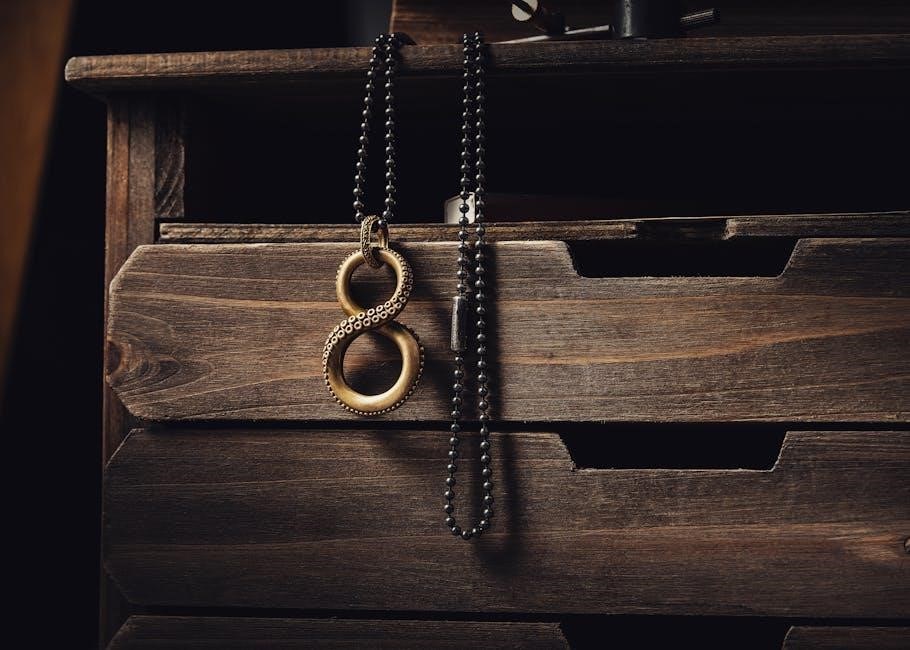
7.2 Repairing Damaged Guides
Repairing damaged wood on wood drawer guides involves assessing the extent of the damage and taking appropriate steps to restore functionality. Start by inspecting the wooden slips and drawer slides for cracks, splits, or wear. For minor damage, sanding the affected areas and applying wood glue or filler can reinforce the structure. If the damage is more severe, replace the damaged slips or slides with new ones, ensuring they are properly aligned and secured. Use wood screws or adhesive to reattach the components. After repairs, test the drawer to ensure smooth operation and make adjustments as needed. Regular inspection and timely repairs can prevent further damage and extend the lifespan of the drawer system.
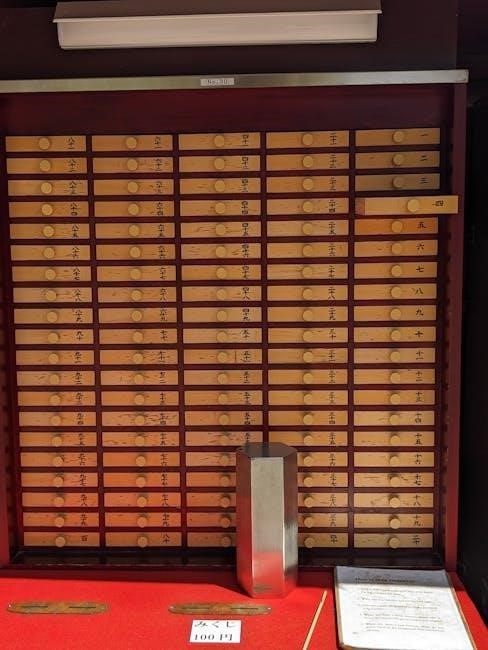
7.3 Preventing Wear and Tear
Preventing wear and tear on wood on wood drawer guides involves regular maintenance and careful usage. Clean the guides periodically with a soft cloth to remove dirt and dust, which can cause friction. Apply a small amount of wax or silicone-based lubricant to the contact points to ensure smooth operation. Avoid overloading drawers, as excessive weight can strain the wooden components. Sand down any rough spots or splinters to maintain even movement. Additionally, check the alignment of the drawer and guides to prevent uneven stress. By addressing these factors, you can significantly extend the lifespan of your wood on wood drawer guides and maintain their functionality over time.
Wood on wood drawer guides remain a timeless choice, offering durability and aesthetic appeal. With proper care, they continue to be a reliable option for furniture design.
8.1 Summary of Benefits
Wood on wood drawer guides offer a timeless, traditional appeal while providing smooth and quiet operation. Their durability ensures long-lasting performance with minimal maintenance. These guides are often preferred for their aesthetic compatibility with classic furniture designs. Unlike metal slides, they avoid the risk of rust or corrosion, making them a reliable choice. Additionally, wood on wood systems are generally easier to install and repair, especially for DIY enthusiasts. They also align with eco-friendly and sustainable furniture trends, as they are made from natural materials. Overall, their simplicity, functionality, and charm make them a popular choice for both modern and traditional furniture designs.
8.2 Evolution and Innovations
Wood on wood drawer guides have evolved significantly, blending traditional craftsmanship with modern innovations. Early designs relied on simple grooved slips, while contemporary versions incorporate advanced materials and finishes for enhanced durability. The use of hardwoods like oak and maple ensures strength, while modern manufacturing techniques improve precision. Recent innovations include self-lubricating finishes and adjustable components for smoother operation. These updates address historical issues like wear and tear, offering a more robust solution. The integration of sustainable practices has also emerged, aligning with eco-conscious trends. Such advancements ensure wood on wood drawer guides remain relevant in both traditional and modern furniture designs, balancing functionality with timeless aesthetics.
8.3 Final Thoughts
Wood on wood drawer guides represent a timeless blend of tradition and functionality, offering a simple yet durable solution for furniture design. Their reliance on natural materials and craftsmanship ensures a smooth, noise-free operation and an aesthetic that complements various design styles. While modern alternatives like metal slides have gained popularity, wood on wood guides remain a preferred choice for many due to their classic appeal and minimal maintenance requirements. For craftsmen and homeowners valuing sustainability and authenticity, these guides embody a harmonious balance between form and function. As furniture trends evolve, wood on wood drawer guides continue to stand as a testament to enduring craftsmanship and timeless design.



